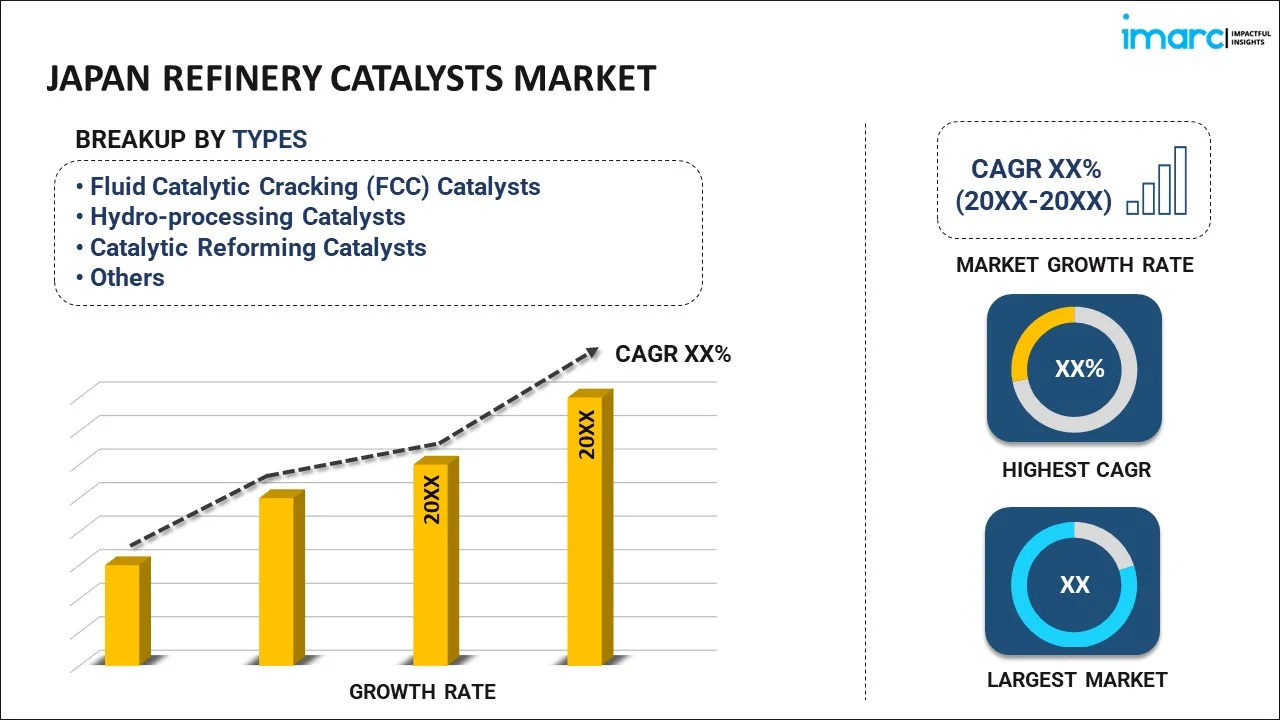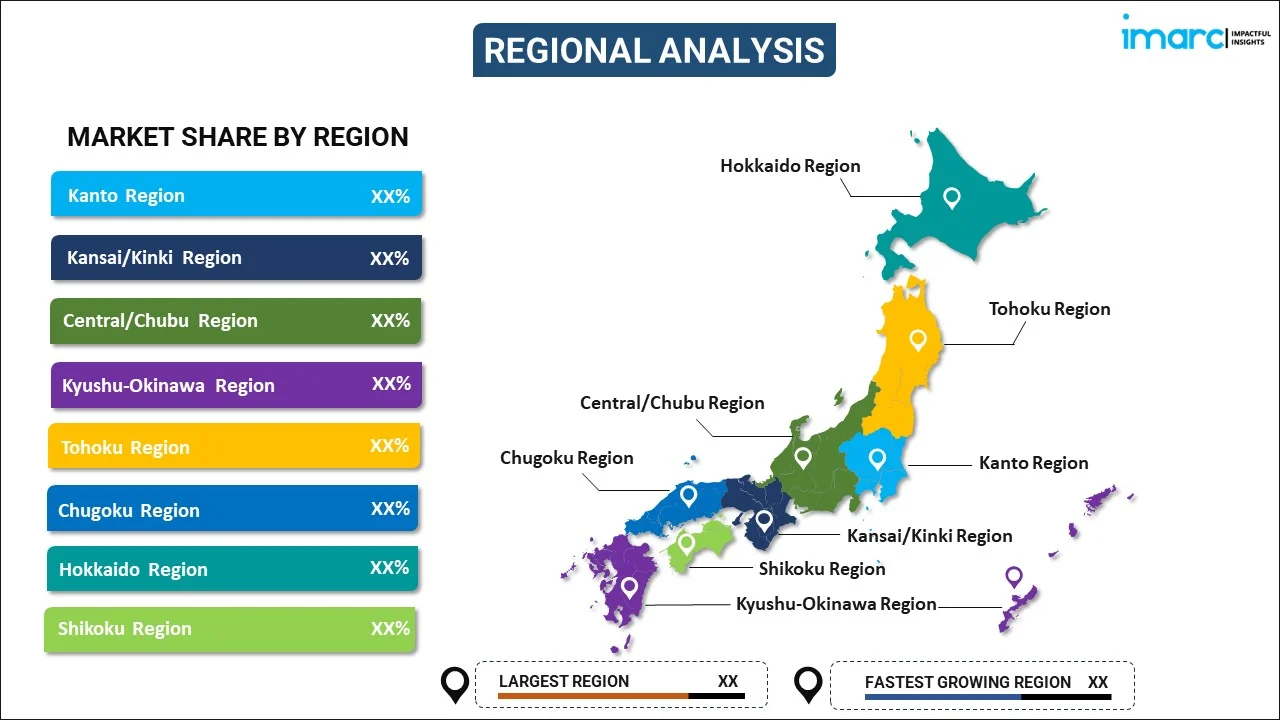
Japan Refinery Catalysts Market Report by Type (Fluid Catalytic Cracking (FCC) Catalysts, Hydro-processing Catalysts, Catalytic Reforming Catalysts, and Others), Material (Zeolites, Metals, Chemical Compounds), and Region 2025-2033
Market Overview:
Japan refinery catalysts market size reached USD 183.4 Million in 2024. Looking forward, IMARC Group expects the market to reach USD 288.2 Million by 2033, exhibiting a growth rate (CAGR) of 4.6% during 2025-2033. The inflating demand for energy, which leads to increased production of refined petroleum products, such as gasoline and diesel, requiring refinery catalysts to optimize refining processes, is driving the market.
|
Report Attribute
|
Key Statistics
|
|---|---|
|
Base Year
|
2024 |
|
Forecast Years
|
2025-2033
|
|
Historical Years
|
2019-2024
|
| Market Size in 2024 | USD 183.4 Million |
| Market Forecast in 2033 | USD 288.2 Million |
| Market Growth Rate (2025-2033) | 4.6% |
Refinery catalysts are critical components in the oil refining industry, playing a pivotal role in the conversion of crude oil into valuable products like gasoline, diesel, and petrochemicals. These catalysts are substances that enhance the speed and efficiency of chemical reactions within the refining process, allowing for the production of higher-quality and more environmentally friendly fuels. The primary function of refinery catalysts is to facilitate various refining processes, such as hydrocracking, hydrotreating, catalytic reforming, and isomerization. They achieve this by lowering the activation energy required for these reactions, enabling them to occur at lower temperatures and pressures. As a result, the refinery can produce more desirable products while minimizing energy consumption and reducing environmental emissions. Common refinery catalysts include zeolites, metals like platinum and palladium, and various proprietary formulations. These catalysts are carefully selected and tailored for specific refining applications to maximize their effectiveness. Refinery catalysts not only improve product quality but also contribute to the economic and environmental sustainability of the refining industry by reducing waste and energy consumption in the production of essential petroleum-based products.
Japan Refinery Catalysts Market Trends:
The refinery catalysts market in Japan is poised for substantial growth in the coming years due to several key drivers. Firstly, the rising regional demand for petroleum products, including gasoline and diesel, acts as a catalyst in itself, propelling the need for efficient refining processes. Additionally, stringent environmental regulations are pushing refineries to adopt cleaner and more efficient catalyst technologies, driving market expansion further. Furthermore, the increasing focus on renewable energy sources has led to a surge in biofuel production, necessitating innovative catalysts to enhance biofuel refining processes. In parallel, the ever-evolving automotive industry, with a shift towards cleaner and more fuel-efficient vehicles, necessitates advanced catalysts to meet stringent emissions standards. Moreover, the ongoing trend of heavy crude oil processing, often containing high levels of impurities, fuels the demand for catalysts that can efficiently handle these challenging feedstocks. In conclusion, a confluence of factors, including increased demand for petroleum products, environmental regulations, biofuel production, automotive advancements, heavy crude processing, and regional expansion, collectively act as significant drivers propelling the refinery catalysts market forward.
Japan Refinery Catalysts Market Segmentation:
IMARC Group provides an analysis of the key trends in each segment of the market, along with forecasts at the country level for 2025-2033. Our report has categorized the market based on type and material.
Type Insights:

- Fluid Catalytic Cracking (FCC) Catalysts
- Hydro-processing Catalysts
- Hydrotreating Catalysts
- Hydrocracking Catalysts
- Catalytic Reforming Catalysts
- Others
The report has provided a detailed breakup and analysis of the market based on the type. This includes fluid catalytic cracking (FCC) catalysts, hydro-processing catalysts (hydrotreating catalysts and hydrocracking catalysts), catalytic reforming catalysts, and others.
Material Insights:
- Zeolites
- Natural Zeolites
- Synthetic Zeolites
- Metals
- Rare Earth Metals
- Transition and Base Metals
- Chemical Compounds
- Sulphuric Acid and Hydrofluric Acid
- Calcium Carbonate
A detailed breakup and analysis of the market based on the material have also been provided in the report. This includes zeolites (natural zeolites and synthetic zeolites), metals (rare earth metals and transition and base metals), and chemical compounds (sulphuric acid and hydrofluric acid and calcium carbonate).
Regional Insights:

- Kanto Region
- Kansai/Kinki Region
- Central/ Chubu Region
- Kyushu-Okinawa Region
- Tohoku Region
- Chugoku Region
- Hokkaido Region
- Shikoku Region
The report has also provided a comprehensive analysis of all the major regional markets, which include Kanto Region, Kansai/Kinki Region, Central/ Chubu Region, Kyushu-Okinawa Region, Tohoku Region, Chugoku Region, Hokkaido Region, and Shikoku Region.
Competitive Landscape:
The market research report has also provided a comprehensive analysis of the competitive landscape. Competitive analysis such as market structure, key player positioning, top winning strategies, competitive dashboard, and company evaluation quadrant has been covered in the report. Also, detailed profiles of all major companies have been provided.
Japan Refinery Catalysts Market Report Coverage:
| Report Features | Details |
|---|---|
| Base Year of the Analysis | 2024 |
| Historical Period | 2019-2024 |
| Forecast Period | 2025-2033 |
| Units | Million USD |
| Scope of the Report | Exploration of Historical Trends and Market Outlook, Industry Catalysts and Challenges, Segment-Wise Historical and Future Market Assessment:
|
| Types Covered |
|
| Materials Covered |
|
| Regions Covered | Kanto Region, Kansai/Kinki Region, Central/ Chubu Region, Kyushu-Okinawa Region, Tohoku Region, Chugoku Region, Hokkaido Region, Shikoku Region |
| Customization Scope | 10% Free Customization |
| Post-Sale Analyst Support | 10-12 Weeks |
| Delivery Format | PDF and Excel through Email (We can also provide the editable version of the report in PPT/Word format on special request) |
Key Questions Answered in This Report:
- How has the Japan refinery catalysts market performed so far and how will it perform in the coming years?
- What has been the impact of COVID-19 on the Japan refinery catalysts market?
- What is the breakup of the Japan refinery catalysts market on the basis of type?
- What is the breakup of the Japan refinery catalysts market on the basis of material?
- What are the various stages in the value chain of the Japan refinery catalysts market?
- What are the key driving factors and challenges in the Japan refinery catalysts?
- What is the structure of the Japan refinery catalysts market and who are the key players?
- What is the degree of competition in the Japan refinery catalysts market?
Key Benefits for Stakeholders:
- IMARC’s industry report offers a comprehensive quantitative analysis of various market segments, historical and current market trends, market forecasts, and dynamics of the Japan refinery catalysts market from 2019-2033.
- The research report provides the latest information on the market drivers, challenges, and opportunities in the Japan refinery catalysts market.
- Porter's five forces analysis assist stakeholders in assessing the impact of new entrants, competitive rivalry, supplier power, buyer power, and the threat of substitution. It helps stakeholders to analyze the level of competition within the Japan refinery catalysts industry and its attractiveness.
- Competitive landscape allows stakeholders to understand their competitive environment and provides an insight into the current positions of key players in the market.
Need more help?
- Speak to our experienced analysts for insights on the current market scenarios.
- Include additional segments and countries to customize the report as per your requirement.
- Gain an unparalleled competitive advantage in your domain by understanding how to utilize the report and positively impacting your operations and revenue.
- For further assistance, please connect with our analysts.
 Inquire Before Buying
Inquire Before Buying
 Speak to an Analyst
Speak to an Analyst
 Request Brochure
Request Brochure
 Request Customization
Request Customization




.webp)




.webp)












